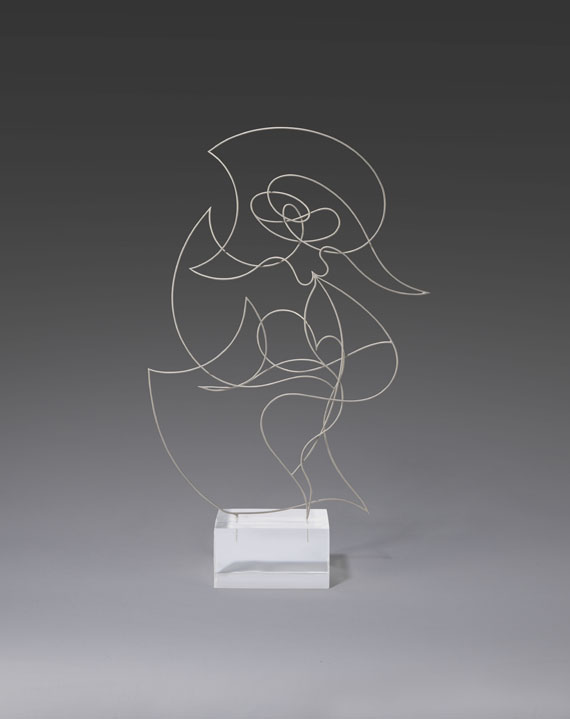PROPERTY FROM A PRIVATE ITALIAN COLLECTION GIACOMO BALLA (1871-1958) "Fluiditá" Primavera signed and inscribed 'Balla Futurista' (lower right); signed, inscribed and dated 'Balla Futurista "Fluiditá Primavera,, 1917' (on the reverse) oil on canvas 40 x 30.5cm (15 3/4 x 12in). Painted in 1917 Fußnoten The authenticity of this work has kindly been confirmed by Dott.ssa Elena Gigli. Provenance Guido Le Noci Collection, Galleria Apollinaire, Milan (acquired directly from the artist in the 1950s). Private collection, Milan. Private collection, Sarzana (2010). Private collection, Italy. Exhibited Rome, Galleria Futurism & Co., Futurism senza Tema, 15 May - 12 July 2019. Giacomo Balla's 1917 canvas, "Fluiditá" Primavera, was created by the Italian Futurist as part of a series of meditations on the seasons. As the First World War drew to a terrible close, Balla retreated to nature, to celebrate its simplicity and beauty in a stunning group of works filled with colour and vitality. During this time Balla was in the process of transforming his own interpretation of Futurism from a focused study of movement and dynamism to a more generous and enveloping study of the world around him. Maurizio Fagiolo dell'Arco named this period 'The Crisis of Futurism' and stated that during this time 'only Balla continued to experiment, but he changed his subject matter and cycle' (M. Fagiolo dell'Arco, Balla, the Futurist, Milan, 1987, p. 42). The death of Balla's pupil (and leading light of the group), Umberto Boccioni in 1916 threw the Futurist movement into disarray: Carlo Carrà moved towards metaphysical experiments, Severini returned to the Cubist language, and Russolo retired from painting. While Marinetti remained actively engaged with the theoretical activities of the movement, it fell to Balla to retain the spirit of Futurism in painting, but the war and new developments in art brought a distinct new vision to his paintings from 1917 onwards. His work during the post-war period falls into a small number of distinct areas of exploration, one of which is sensation and synthesis. "Fluiditá" Primavera certainly hails from this strand of Balla's theoretical and decorative experiments. As the title denotes, Balla turns his focus to nature and attempts to show the viewer the sensation of its force, animating the trees, grass and wind all at once in a harmonic display of natural grace. The work belongs to a series of paintings such as Dissolvimento autumnale and Estate dedicated to Spring, Summer and Autumn created during the years 1917-1920. Spring seemed to be a subject of particular interest, being the season he depicted the most and indeed showcased in the magesterial Espansione di primavera of 1918, that resides in the collection of the Museo del Novecento in Milan. Giovanni Lista notes that the change of seasons inspired a particular creativity in Balla: 'The theme of spring, that is, the rebirth of nature after the hibernation of winter, inspired him as early as Primaverilis, a painting with evocative larval forms that strangely recall the biomorphic delirium of Salvador Dalí Balla creates a surreal effect through a series of curves that are repeated, echoing each other, translating the double movement of the energy that circulates between the plants and the earth. By approaching the same theme, in Fluiditá di Primavera he elaborates a denser and less aerial composition. He accentuates the figurative elements, whilst dematerializes them with the fluid lines of the life force that rises in the trees and nourishes their growth' (G. Lista, 'Sensazione ed energia' in Balla, la Modernitá Futurista, Milan, 2008, p. 224). From 1912 until 1917, Balla had searched for dynamism in man-made forms – cars, motorcycles, architecture – and yet from 1917 onwards he found this dynamism in nature itself. It is interesting to note that the landscapes he painted in this period are entirely figureless, allowing Balla to concentrate on the pure expressions of natu
PROPERTY FROM A PRIVATE ITALIAN COLLECTION GIACOMO BALLA (1871-1958) "Fluiditá" Primavera signed and inscribed 'Balla Futurista' (lower right); signed, inscribed and dated 'Balla Futurista "Fluiditá Primavera,, 1917' (on the reverse) oil on canvas 40 x 30.5cm (15 3/4 x 12in). Painted in 1917 Fußnoten The authenticity of this work has kindly been confirmed by Dott.ssa Elena Gigli. Provenance Guido Le Noci Collection, Galleria Apollinaire, Milan (acquired directly from the artist in the 1950s). Private collection, Milan. Private collection, Sarzana (2010). Private collection, Italy. Exhibited Rome, Galleria Futurism & Co., Futurism senza Tema, 15 May - 12 July 2019. Giacomo Balla's 1917 canvas, "Fluiditá" Primavera, was created by the Italian Futurist as part of a series of meditations on the seasons. As the First World War drew to a terrible close, Balla retreated to nature, to celebrate its simplicity and beauty in a stunning group of works filled with colour and vitality. During this time Balla was in the process of transforming his own interpretation of Futurism from a focused study of movement and dynamism to a more generous and enveloping study of the world around him. Maurizio Fagiolo dell'Arco named this period 'The Crisis of Futurism' and stated that during this time 'only Balla continued to experiment, but he changed his subject matter and cycle' (M. Fagiolo dell'Arco, Balla, the Futurist, Milan, 1987, p. 42). The death of Balla's pupil (and leading light of the group), Umberto Boccioni in 1916 threw the Futurist movement into disarray: Carlo Carrà moved towards metaphysical experiments, Severini returned to the Cubist language, and Russolo retired from painting. While Marinetti remained actively engaged with the theoretical activities of the movement, it fell to Balla to retain the spirit of Futurism in painting, but the war and new developments in art brought a distinct new vision to his paintings from 1917 onwards. His work during the post-war period falls into a small number of distinct areas of exploration, one of which is sensation and synthesis. "Fluiditá" Primavera certainly hails from this strand of Balla's theoretical and decorative experiments. As the title denotes, Balla turns his focus to nature and attempts to show the viewer the sensation of its force, animating the trees, grass and wind all at once in a harmonic display of natural grace. The work belongs to a series of paintings such as Dissolvimento autumnale and Estate dedicated to Spring, Summer and Autumn created during the years 1917-1920. Spring seemed to be a subject of particular interest, being the season he depicted the most and indeed showcased in the magesterial Espansione di primavera of 1918, that resides in the collection of the Museo del Novecento in Milan. Giovanni Lista notes that the change of seasons inspired a particular creativity in Balla: 'The theme of spring, that is, the rebirth of nature after the hibernation of winter, inspired him as early as Primaverilis, a painting with evocative larval forms that strangely recall the biomorphic delirium of Salvador Dalí Balla creates a surreal effect through a series of curves that are repeated, echoing each other, translating the double movement of the energy that circulates between the plants and the earth. By approaching the same theme, in Fluiditá di Primavera he elaborates a denser and less aerial composition. He accentuates the figurative elements, whilst dematerializes them with the fluid lines of the life force that rises in the trees and nourishes their growth' (G. Lista, 'Sensazione ed energia' in Balla, la Modernitá Futurista, Milan, 2008, p. 224). From 1912 until 1917, Balla had searched for dynamism in man-made forms – cars, motorcycles, architecture – and yet from 1917 onwards he found this dynamism in nature itself. It is interesting to note that the landscapes he painted in this period are entirely figureless, allowing Balla to concentrate on the pure expressions of natu















Try LotSearch and its premium features for 7 days - without any costs!
Be notified automatically about new items in upcoming auctions.
Create an alert